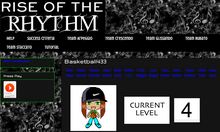
Back Ludificació de l'aprenentatge Catalan Ludificación del aprendizaje Spanish بازیوارسازی آموزشی Persian Zwa Mitambo ya u guda VE
The gamification of learning is an educational approach that seeks to motivate students by using video game design and game elements in learning environments.[1][2] The goal is to maximize enjoyment and engagement by capturing the interest of learners and inspiring them to continue learning.[3] Gamification, broadly defined, is the process of defining the elements which comprise games, make those games fun, and motivate players to continue playing, then using those same elements in a non-game context to influence behavior.[4] In other words, gamification is the introduction of game elements into a traditionally non-game situation.
There are two forms of gamification: structural, which means no changes to subject matter, and the altered content method that adds subject matter.[5] Games applied in learning can be considered serious games, or games where the learning experience is centered around serious stories. A serious story needs to be both "impressive in quality" and "part of a thoughtful process" to achieve learning goals.[6]
In educational contexts, examples of desired student behavior as a result of gamification include attending class, focusing on meaningful learning tasks, and taking initiative.[7][8]

Gamification of learning does not involve students in designing and creating their own games or in playing commercially produced video games, making it distinguishable from game-based learning, or using educational games to learn a concept. Within game-based learning initiatives, students might use Gamestar Mechanic or GameMaker to create their own video game or explore and create 3D worlds in Minecraft. In these examples, the learning agenda is encompassed within the game itself.
Some authors contrast gamification of learning with game-based learning. They claim that gamification occurs only when learning happens in a non-game context, such as a school classroom. Under this classification, when a series of game elements is arranged into a "game layer," or a system which operates in coordination with learning in regular classrooms, then gamification of learning occurs.[9] Other examples of gamified content include games that are created to induce learning.[10]
- ^ Kapp, Karl (2012). The Gamification of Learning and Instruction: Game-based Methods and Strategies for Training and Education. Pfeiffer. ISBN 978-1118096345.
- ^ Shatz, Itamar (2015). Using Gamification and Gaming in Order to Promote Risk Taking in the Language Learning Process (PDF). MEITAL National Conference. Haifa, Israel: Technion. pp. 227–232. Archived from the original (PDF) on 7 March 2016. Retrieved 4 August 2016.
- ^ Cite error: The named reference
2013H&Swas invoked but never defined (see the help page). - ^ Deterding, Sebastian; Dixon, Dan; Khaled, Rilla; Nacke, Lennart (2011). From game design elements to gamefulness: defining 'gamification'. 15th International MindTrek Conference. New York: ACM. pp. 9–15. doi:10.1145/2181037.2181040. ISBN 9781450308168. Retrieved 4 August 2016.
- ^ Kapp, Karl (2012). The gamification of learning and instruction: Game-based methods and strategies for training and education. San Francisco: Pfeiffer. ISBN 9781118096345.
- ^ Lugmayr, Artur; Suhonen, Jarkko; Hlavacs, Helmut; Montero, Calkin; Suutinen, Erkki; Sedano, Carolina (2016). "Serious storytelling – a first definition and review". Multimedia Tools and Applications. 76 (14): 15707–15733. doi:10.1007/s11042-016-3865-5. S2CID 207219982.
- ^ Borys, Magdelena; Laskowski, Maciej (19–21 June 2013). Implementing game elements into didactic process: A case study (PDF). Management, Knowledge and Learning International Conference. Zadar, Croatia. pp. 819–824. ISBN 9789616914024. Retrieved 4 August 2016.
- ^ Borges, Simone; Durelli, Vinicius; Reis, Helena; Isotani, Seiji (24–28 March 2014). A systematic mapping on gamification applied to education. ACM Symposium on Applied Computing. Gyeongju, Republic of Korea. pp. 216–222. doi:10.1145/2554850.2554956. ISBN 9781450324694. Retrieved 4 December 2020.
- ^ Cite error: The named reference
2012Wwas invoked but never defined (see the help page). - ^ Kapp (2012), p. 200: "result of the brainstorming process ... is the creation of a gamification design document outlining the design of the game ..."